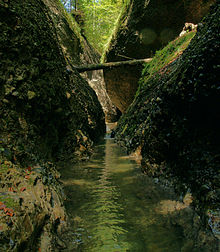Seeblibach
| Seeblibach | ||
|
The Seeblibach eats its way through the Nagelfluh |
||
| Data | ||
| Water code | CH : 527 | |
| location | Canton of Lucerne ; Switzerland | |
| River system | Rhine | |
| Drain over | Fontannen → Kleine Emme → Reuss → Aare → Rhine → North Sea | |
| source | at Oberegelshorn 46 ° 59 '35 " N , 7 ° 57' 5" O |
|
| Source height | 1075 m | |
| muzzle | south of Romoos in the Grosse Fontannen Coordinates: 46 ° 58 ′ 48 ″ N , 8 ° 0 ′ 24 ″ E ; CH1903: 643227 / 203360 46 ° 58 '48 " N , 8 ° 0' 24" O |
|
| Mouth height | 749 m | |
| Height difference | 326 m | |
| Bottom slope | 63 ‰ | |
| length | 5.2 km | |
| Catchment area | 12.3 km² | |
| Discharge at the mouth of the A Eo : 12.3 km² |
MQ Mq |
320 l / s 26 l / (s km²) |
| Left tributaries | Egelshorngraben , Goldbach | |
| Communities | Romoos | |
The Seeblibach is a five kilometer long tributary of the Grosse Fontannen south of the Napf in the Entlebuch district . It rises in three source streams near Oberegelshorn in the Sprossemoosgrabe on the border with the canton of Bern . Below the Sonnweidli it flows into the Grosse Fontanne. The Seeblibach, like all rivers and streams in the Napfbergland, is well known beyond the region for its gold deposits, which are small but extremely pure.
Glass blowing
Because of the fine quartz sand and the surrounding forests, Seeblibach and Fontannen attracted the first glassmakers in the 18th century. In 1741 glassmakers from the Black Forest settled below the Pilgereggweid on the Seeblibach. After a short time, the hamlet had more than ten buildings, including a chapel and a tavern, and the glassworks sometimes employed more than a hundred people. In 1781 the wood resources around the glassworks were completely exhausted and the glassworks at Fontannen and Seeblibach could no longer be operated. It was abandoned and a new glassworks built in Flühli until the wood there too was exhausted. Around 1817, today's " Glasi Hergiswil " was built in Hergiswil am See . The field name "Glashüttli" still reminds us of the glassworks about a hundred meters west of the influence in the Grosse Fontanne. The Pilgereggweid settlement is also only known by the field name of the same name.
Charcoal burning
The forests have recovered from glass production and in the Drachslis, a farm on the Seeblibach, since 1977 there have been regular charcoal makers who traditionally produce large quantities (approx. 100 tons per year) with charcoal piles.
Individual evidence
- ↑ a b c d Geoserver of the Swiss Federal Administration ( information )
- ↑ Modeled mean annual discharge. In: Topographical catchment areas of Swiss waters: area outlets. Retrieved October 31, 2015 .


